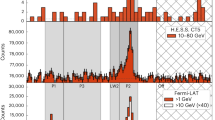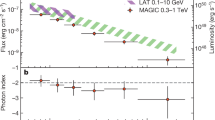Abstract
OF the more than 500 known radio pulsars, only three have been detected as γ-ray sources. Using the Energetic Gamma Ray Experiment Telescope (EGRET) on the Compton Gamma Ray Observatory satellite, we have detected pulsed γ-radiation, above 100 MeV in energy, from a fourth radio pulsar, PSR1706–44. Within the pulse period of 102 ms, the γ-emission forms a single broad peak, in contrast to the two narrow peaks seen in the other high-energy γ-ray pulsars. The emission mechanism in all cases is probably the same, the differences arising from the geometry of the magnetic and rotation axes and the line of sight. In these pulsars, γ-ray emission accounts for as much as 1% of the total neutron star spin-down energy, much more than emerges at optical or radio frequencies, so study of this emission is important in understanding pulsar emission and evolution.
This is a preview of subscription content, access via your institution
Access options
Subscribe to this journal
Receive 51 print issues and online access
$199.00 per year
only $3.90 per issue
Buy this article
- Purchase on Springer Link
- Instant access to full article PDF
Prices may be subject to local taxes which are calculated during checkout
Similar content being viewed by others
References
Thompson, D. J., Fichtel, C. E., Hartman, R. C., Kniffen, D. A. & Lamb, R. C. Astrophys. J. 213, 252–262 (1977).
Kanbach, G. et al. Astr. Astrophys. 90, 163–169 (1980).
Ögelman, H. B., Fichtel, C. E., Kniffen, D. A. & Thompson, D. J. Astrophys. J. 209, 584–591 (1976).
Thompson, D. J., Bertsch, D. L., Hartman, R. C. & Hunter, S. D. Astr. Astrophys. 127, 220–223 (1983).
Buccheri, R. et al. Astr. Astrophys. 128, 245–251 (1983).
Harding, A. K. Astrophys. J. 245, 267–273 (1981).
Ruderman, M. & Cheng, K. S. Astrophys. J. 335, 306–318 (1988).
Wilson, R. B. et al. IAU Circ. No. 5429 (1992).
Halpern, J. P. & Holt, S. S. Nature 357, 222–224 (1992).
Bertsch, D. L. et al. Nature 357, 306–307 (1992).
Hughes, E. B. et al. IEEE Trans. Nucl. Sci. NS-27, 364–369 (1980).
Kanbach, G. et al. Space Sci. Rev. 49, 69–84 (1988).
Kanbach, G. Gamma Ray Obs. Sci. Workshop Proc., 2-1–2-10 (1989).
Swanenburg, B. N. et al. Astrophys. J. 243, L69–L73 (1981).
Johnston, S. et al. Mon. Not. R. astr. Soc. 255, 401–411 (1992).
Thompson, D. J. et al. Astrophys. J. Suppl. (in the press).
DeJager, O. C., Swanepoel, J. W. H. & Raubenheimer, B. C. Astr. Astrophys. 221, 180–190 (1978).
Buccheri, R. et al. Astr. Astrophys. 69, 141–142 (1978).
Clear, J. et al. Astr. Astrophys. 174, 85–94 (1987).
Grenier, I. A., Hermsen, W. & Clear, J. Astr. Astrophys. 204, 117–132 (1988).
Daugherty, J. K. & Harding, A. Astrophys. J. 252, 337–347 (1982).
Cheng, K. S., Ho, C. & Ruderman, M. Astrophys. J. 300, 500–521 (1986).
Author information
Authors and Affiliations
Rights and permissions
About this article
Cite this article
Thompson, D., Arzoumanian, Z., Bertsch, D. et al. Pulsed high-energy γ-rays from the radio pulsar PSRI706–44. Nature 359, 615–616 (1992). https://doi.org/10.1038/359615a0
Received:
Accepted:
Issue Date:
DOI: https://doi.org/10.1038/359615a0
This article is cited by
-
The Harmonic Oscillator in the Classical Limit of a Minimal-Length Scenario
Brazilian Journal of Physics (2016)
-
Regular Particle Acceleration in Relativistic Jets
Astrophysics and Space Science (2005)
-
Gamma-ray pulsars: polar cap or outer gap emission?
Astrophysics and Space Science (1995)
Comments
By submitting a comment you agree to abide by our Terms and Community Guidelines. If you find something abusive or that does not comply with our terms or guidelines please flag it as inappropriate.



